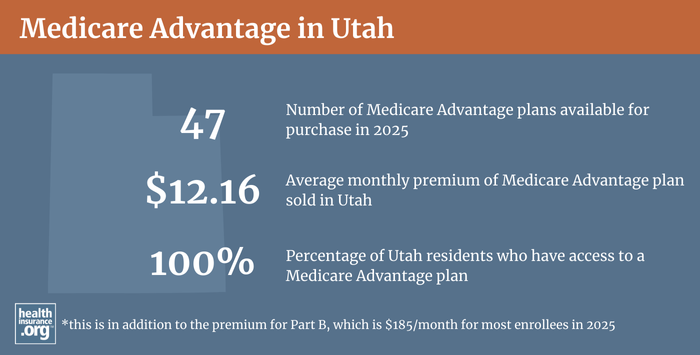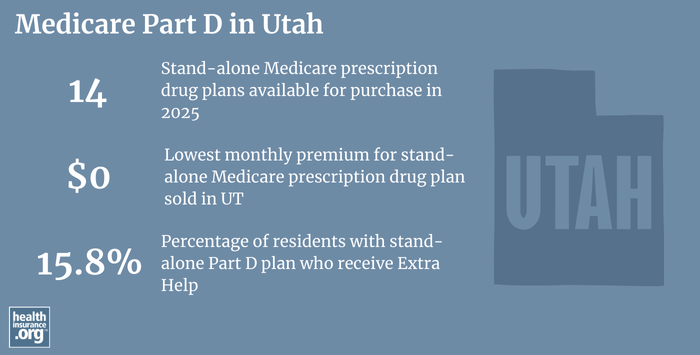
Medicare in Utah
Original Medicare, Medicare Advantage, Part D prescription drug, and Medigap coverage in Utah
Key takeaways
- Less than 13% of Utah residents are enrolled in Medicare.
- 49% of Utah Medicare beneficiaries have Medicare Advantage plans;1 plan availability ranges from fewer than 10 to almost 30 plans, depending on the county.2
- Premiums for stand-alone Part D prescription drug plans in Utah start at $5.10 per month in 2023.3

Utah Medicare enrollment
As of September 2024, there were 465,223 people with Medicare in Utah.4 That’s about 12% of the state’s population.5
Medicare eligibility is also triggered once a person has been receiving disability benefits for 24 months, or is diagnosed with Amyotrophic Lateral Sclerosis or End-Stage Renal Disease. Nationwide, about 11% of all Medicare beneficiaries are under 65 and eligible due to disability.6 In Utah, about 9% of Medicare beneficiaries are eligible because they’re disabled.4
Medicare options
In most areas of the country, Medicare beneficiaries can choose Original Medicare or a Medicare Advantage plan. Medicare Advantage plans are available in most, but not all counties across the United States; all areas of Utah have Medicare Advantage plans available as of 2025.7
Original Medicare includes Part A (which helps pay for inpatient stays, like at a hospital, skilled nursing facility, or hospice center) and Part B (which helps pay for outpatient care like a doctor appointment or a preventive healthcare service, such as vaccinations).
Medicare Advantage plans are administered by private insurance companies, and all of the benefits of Original Medicare are covered. In addition, Medicare Advantage plans typically have offered additional benefits, such as prescription drug, dental, and vision coverage. However, healthcare provider networks may be limited with Medicare Advantage, and out-of-pocket costs are typically higher than an individual would have if they opted for Original Medicare plus a Medigap plan.8 In short, there are pros and cons either way, and no one-size-fits-all solution.
Learn about Medicare plan options in Utah by contacting a licensed agent.



Explore our other comprehensive guides to coverage in Utah

We’ve created this guide to help you understand the Utah health insurance options available to you and your family, and to help you select the coverage that will best fit your needs and budget.


Hoping to improve your smile? Dental insurance may be a smart addition to your health coverage. Our guide explores dental coverage options in Utah.


Learn about Utah’s Medicaid expansion, the state’s Medicaid enrollment and Medicaid eligibility.


Short-term health plans provide temporary health insurance for consumers who may find themselves without comprehensive coverage. Learn more about short-term plan availability in Utah.

Frequently asked questions about Medicare in Utah
What is Medicare Advantage?
In 2018, 36% of people with Medicare in Utah were enrolled in Medicare Advantage plans, the other 64% of Utah’s Medicare beneficiaries had opted for Original Medicare instead.9 But as is the case nationwide, Medicare Advantage plans are becoming increasingly popular: As of March 2023, Medicare Advantage plans covered almost half of the state’s total Medicare population.1 (Utah has tracked very close to the national average, which stood at about 48% as of March 2023)10
Medicare Advantage plans are available throughout Utah in 2023, but quite a few counties have fewer than 5 plans available, while others have almost 30.2
Medicare beneficiaries can switch between Medicare Advantage plans and Original Medicare (and can add or drop a Medicare Part D prescription drug plan) during the Medicare Annual Enrollment Period, which runs from October 15 to December 7 each year. Medicare Advantage enrollees also have the option to switch to a different Medicare Advantage plan or to Original Medicare during the Medicare Advantage Open Enrollment Period, which runs from January 1 to March 31.11
- Read our guide to Medicare’s open enrollment.
- Understand the difference between Medigap, Medicare Advantage, and Medicare Part D.

Medigap enrollment and regulations in Utah
According to AHIP, 81,726 Utah residents were enrolled in Medigap plans in 2023,12 to supplement their Original Medicare coverage.
Learn how Medigap plans are regulated and standardized.
The Utah Insurance Department offers a Medigap plan comparison tool that allows residents to view available plans and premiums.
Federal rules only ensure guaranteed-issue access to Medigap coverage during a person’s initial six-month enrollment window (starting when they’re at least 65 and enrolled in Medicare Part A and B), and during limited special enrollment periods. Federal rules do not provide any sort of annual Medigap enrollment window. Federal rules also do not ensure access to Medigap policies for beneficiaries under the age of 65.
Utah’s Medigap birthday rule
States can go beyond the federal minimums, by establishing additional enrollment and plan change opportunities. Several states have implemented Medigap “birthday rules” to provide an annual plan change opportunity, and Utah joined them in 2025.
Under legislation that took effect in May 2025, Utah Medigap enrollees have an annual 60-day window, starting on their birthday, when they can enroll in a plan with equal or lesser benefits, offered by their current insurer.13
So, for example, a person with Medigap Plan F can use their birthday enrollment window to switch to Plan G from the same insurer they already use. But the limitation on staying with the same insurer is more restrictive than the limits imposed by most other states that have created plan change windows linked to enrollees’ birthdays.
No Medigap plans available for beneficiaries under age 65
Although Utah now ensures at least a limited amount of plan change flexibility for people with Medigap, the state does not require Medigap insurers to offer coverage to Medicare beneficiaries who are under age 65.
As of October 2025, zero Medigap plans were available in Utah for new applicants under the age of 65.14
The majority of the states have taken action to ensure that at least some Medigap plans are available to people who are under 65 and eligible for Medicare due to a disability. But Utah is not among them.
In past years, a very limited number of Medigap policies were offered to Utah applicants under the age of 65. But the Utah Insurance Department reported that as of 2022, only 1.3% of all Medigap enrollees in Utah were under the age of 65.15 The Insurance Department’s report noted that the low enrollment among people under age 65 was likely because Utah does not require Medigap insurers to make their products available to people under the age of 65.
In 2021, the Utah Insurance Department submitted a recommendation to the legislature that the state should enact legislation to require Medigap insurers to offer their policies to disabled Medicare beneficiaries.16 But the legislature had not taken action on this by the fall of 2025.
What is Medicare Part D?
Original Medicare does not cover outpatient prescription drugs. As noted above, more than 80% of Original Medicare beneficiaries nationwide have supplemental coverage via an employer-sponsored plan (from a current or former employer or spouse’s employer) or Medicaid, and these plans often include prescription coverage. But Medicare beneficiaries who don’t have prescription drug coverage through Medicaid or an employer-sponsored plan need to obtain Medicare Part D prescription drug coverage. Medicare Part D prescription drug coverage can be purchased as a stand-alone plan, or as part of a Medicare Advantage plan that includes Part D prescription drug coverage.17
In 2023 in Utah, there are 23 stand-alone Medicare Part D plans for sale, with premiums starting at $5.10 per month.3
As of March 2023, 129,722 Medicare beneficiaries in Utah had stand-alone Medicare Part D prescription drug plans.1 But even more — 207,152 — had Part D prescription drug plans as part of their Medicare Advantage plans.1
Medicare Part D prescription drug plans enrollment follows the same schedule as Medicare Advantage plans: Beneficiaries can select a Medicare Part D prescription drug plan when they’re first eligible for Medicare, and there’s an annual window (October 15 to December 7) when beneficiaries can enroll or make changes to their Medicare Part D prescription drug coverage.

What additional resources are available for Medicare beneficiaries and their caregivers in Utah?
Need help with your Medicare application in Utah, or have questions about Medicare eligibility in Utah? These resources provide free assistance and information.
- Contact the Utah Senior Health Insurance Information Program (SHIP), for questions about Medicare coverage in Utah.
- Visit the Utah Insurance Department website.
- Learn how Medicaid helps Medicare beneficiaries who have limited income and assets.
- Go to the Medicare Rights Center website, which provides offer helpful content geared to Medicare beneficiaries, caregivers, and professionals.
Louise Norris is an individual health insurance broker who has been writing about health insurance and health reform since 2006. She has written dozens of opinions and educational pieces about the Affordable Care Act for healthinsurance.org.

Looking for more information about other options in your state?
Need help navigating health insurance options in Utah?
Explore more resources for options in UT including ACA coverage, short-term health insurance, dental and Medicaid.
Speak to a sales agent at a licensed insurance agency.
Footnotes
- ”Medicare Monthly Enrollment – Utah” Centers for Medicare & Medicaid Services Data, March 2023. ⤶ ⤶ ⤶ ⤶
- Freed, Meredith, and Jeannine Fugelsten Biniek. “Medicare Advantage 2023 Spotlight: First Look.” Kaiser Family Foundation, November 10, 2022. ⤶ ⤶
- “Fact Sheet – Centers for Medicare & Medicaid Services.” Page 32. Centers for Medicare & Medicaid Services, September 29, 2022. ⤶ ⤶
- “Medicare Monthly Enrollment – Utah.” Centers for Medicare & Medicaid Services Data. Accessed January, 2025. ⤶ ⤶
- “U.S. Census Bureau Quick Facts: Utah; United States.” U.S. Census Bureau, July 1, 2024. ⤶
- “Medicare Monthly Enrollment – US” Centers for Medicare & Medicaid Services Data, September 2024. ⤶
- ”Fact Sheet: Medicare Open Enrollment for 2025” (134) Centers for Medicare & Medicaid Services. Sep. 27, 2024 ⤶
- “Understanding Medicare Advantage Plans.” Centers for Medicare & Medicaid Services, July 2022. ⤶
- “Medicare Monthly Enrollment – Utah (2018).” Centers for Medicare & Medicaid Services Data, March 2018. ⤶
- “Medicare Monthly Enrollment – United States.” Centers for Medicare & Medicaid Services Data, March 2023. ⤶
- “Joining a Plan.” Medicare.gov. Accessed July 28, 2023. ⤶
- “The State of Medicare Supplement Coverage” AHIP. May 2025. Accessed Oct. 5, 2025 ⤶
- ”Utah HB258” BillTrack50. Enacted Mar. 26, 2025 ⤶
- “Find a Medigap policy that works for you” Medicare.gov. Accessed Oct. 5, 2025 ⤶
- “2022 Health Insurance Market Report – Utah.” Page 64, State of Utah Insurance Department, December 1, 2022. ⤶
- “2021 Utah Health Insurance Market Report” Utah Insurance Department. Accessed Oct. 5, 2025 ⤶
- “An Overview of the Medicare Part D Prescription Drug Benefit.” Kaiser Family Foundation, October 19, 2022. ⤶

